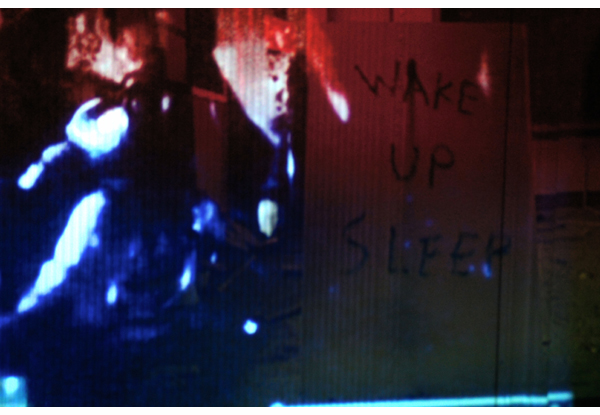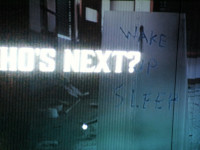
EIKASIA : Video Installation by Alessandro Rolandi
|
IMAGO is the Latin term for our “image” and it is a word carrying multiple meanings and a vague, undisclosed origin: some say it comes from the Latin verb “imitor”, to imitate, some from the ancient Greek word ekmageion (linked to “stoned”); more generally it can be referenced from the Proto-Indo-European aim, aiem, iem, translated as “similarity, resemblance”. Among its various accepted meanings are: image, imitation, likeness, statue, funeral masque, representation, ghost, apparition, semblance, appearance, shadow, echo, conception, thought, reminder, comparison. The first definition as a noun is “the final stage of an insect after undergoing metamorphosis”. It can also express an idealized concept of a loved one, formed in childhood and unaltered in adult life. It is focusing on these last two aspects, transformation and deception, that I started to work and study the nature of our current relationship to images. The Russian philosopher Boris Groys pointed out that an artist today is only someone who create his own image through the constant manipulation of mass media and communication; if this has been accurate until the present generation of “superstars artists”, my feeling is that we are now entering a new level where the images produced by the system are becoming independent: they are affecting art, artists and everything else, co-opting them in a vortex whose increasing acceleration creates and destroys billions of empty signs in a smaller and smaller amount of time, atomizing and re-combining reality and perception. Space and time are constantly deformed, cut up, edited and redistributed to users who also contribute unwillingly with further layers of intervention and modification. Mass media, social media, data collecting, full time surveillance and connectivity through our prosthetic devices, phones, tablets, glasses and so on, have started the process of integrating human beings into the new bio-technological dimension where algorithms are analyzing big data at billions of nano-seconds speed and creating the next most repressive social architecture of human history. The scholar Frank Pasquale in his new published book The Black Box Society debates issues such as “digital reputation”, secrecy, opacity and obfuscation related to big data servers and their intrusion and impact on our lives, pointing out how the boundaries between State power, marketing, social engineering, political propaganda and new warfare strategy are becoming blurred and undifferentiated. This enormous quantity of images, the sophistication of the psychological and bio-political techniques that creates them and the huge amount of financial and political power behind their makers is progressively altering and distorting not only the notion of reality, but the idea of knowledge itself. Since 1946 thanks to the work of W.R. Russell and Nathan scientist have become aware of the relationship of post-perceptual visual processes to time. The storage of mental images is never instantaneous, it has to do with the process of perception and it is precisely this storage process that is rejected today. Teachers have been saying for a while that the last generations have great difficulty understanding what they read because they are incapable of re-presenting it to themselves: for them words have in the end lost their capacity to come alive, since images, more rapidly perceived have replaced words according to the system of cinema, propaganda and advertisement from the early XX century until virtual and online communication in the present time. Now there is no longer anything to replace. Recent studies on dyslexia have established a direct connection between the subject’s visual abilities on one hand and language and reading on the other. Frequently a weakening of central (foveal) vision is recorded, the site of the most acute sensation, along with a consequent enhancing of a more or less frantic peripheral vision: it is a dissociation of sight in which the heterogeneous swamps the homogeneous. This means that, as in narcotic states, the series of visual impressions become meaningless. They no longer seem to belong to us they just exist, as though the speed of light had won out, over the totality of the message. As Paul Virilio points out “ The race between the transtextual and the transvisual ran on until the emergence of the instantaneous ubiquity of the audiovisual mix” Simultaneously in our “connected society” the ultimate transfer undermines the age-old problem of the “site where mental images are formed” as well as that of the consolidation of natural memory. With the industrial proliferation of visual and audio-visual prosthetic devices and unrestrained use of instantaneous-transmission equipment, from early childhood onwards, we now routinely see the encoding of increasing elaborate mental images together with a steady decline in retention and recall. We are actually looking at the rapid collapse of mnemonic consolidation. The computer generated artificial intelligence has become responsible, rather than the viewer, for the machine’s capacity to analyze the environment and automatically interpret the meaning of events. This prepares the automation of perception according to which the analysis of objective reality is delegating to a machine, but as we know, the virtual image is the formation of optical imagery with no apparent base, no permanency beyond that of instrumental visual memory. The development of virtual imagery influences human behavior with a new industrialization of vision and the growth of a veritable market in synthetic perception, with ll the ethical questions this brings up. We have to deal with this situation not only in relation to the growing implementation of control and surveillance, or to the developing phobias such as persecution mania or chronic anxiety, but also in relation to the philosophical question of the “splitting of the viewpoint” , the sharing of perception of the environment between the living subject(animate) and the seeing-machine (inanimate). Once we will be totally removed from the realm of direct and indirect observation of synthetic images created by the machine for the machine, images will be for us something foreigner, an enigma, the sphinx of the post-human condition. Art with its visual arsenal, has failed its revolutionary attempt to merge with life, but life has completely succeeded its process to become fully aestheticized and designed. Marketing, communication, pattern recognition, and statistical analysis are the disciplines claiming the leadership to shape the future and a radical dissociation appears between these dominant forms of technical knowledge, the standardized opinions and behaviors that constitute the available knowledge of the masses (as a result of their constant exposure to this manipulation) and the possibility of a different philosophic and spiritual knowledge fostering compassion, empathy and mutual respect (which one part of the creative community would like to build) .From inside these deep fractures new forms of violence previously unknown, are growing and spreading around. A nihilist violence resulting from the emotional, spiritual and educational ravages inflicted on civilization by consumerism, a kind of violence falsely pretending to endorse a cause or a belief, but effectively coming by the self-imposed shifting of desire from Eros to Thanathos. Antonio Gramsci resumed in one sentence from his prison notebooks “The old world dies and the new one cannot see the light: from this chiaro-scuro all the monsters appear”. Similarly another Italian intellectual, Pier Paolo Pasolini, in an interview released for the State TV, took the last couple of minutes to state that if Fascism did not touch or change the spirit of the Italian society, the new Fascism, Consumerism, had indeed succeeded in bringing forward a deep, devastating and irreversible transformation of the social fabric. It was 1962. After 53 years these words sound prophetic and disturbing, announcing a world that with a simplified generalization (one more) distances itself from a Pre-socratic and Socratic attitude towards knowledge, doubt and awareness, and exists merely between the empty rethoric of millions of Sophists and the frightening appearance of Platonic uncompromising dualism. And, if we have to remain with Plato, it is evident that our world has become a giant “reversed cave” in which all images are in fact shadows of themselves, doubles and inconsistent reality leftovers, where surveillance and control are becoming mandatory and freedom and difference eroded and erased. Plato again, in his four definitions, calls this form of knowledge EIKASIA; literally this means “picture-thinking”, reflecting the thinking that derives not from the reality of things but from their images in our minds. Fears, anxieties, wishes, day-dreams, phantasms, and other specific scenes or imagined scenes from which a train of thought proceeds. Eikasia is related in modernity to the idea of fictional finalisms in the system of psychologist Alfred Adler. Adler noticed how extensively human beings are motivated by specific imagined scenes that determine and direct our actions. According to fictional finalisms is that we proceed as if these images were real events, even though they are only imagined. At sub or unconscious level, we tend not to make the cognitive distinction between an imagined idea and a fact. I believe today we are already living in an induced state of EIKASIA with slightly different characteristics in different places. In China for example, the use of images and communication is still largely relying on occultation and secrecy, (selecting, filtering and censoring specific images and avoiding a large variety) while in the West the strategy is more that of obfuscation: providing such an enormous mass of information and images that it becomes impossible to discriminate which ones are relevant, what is real and what can be trusted. Denying information or denying the relevant information are the new faces of the same coin. Within the spectrum of these two hedges different political and economic powers in different countries are building their control systems and imposing them on us. We are all aware of this, but this awareness generates revolt among the very few and mostly resigned acceptance, exhaustion and apathy among the many. Perhaps the mechanism is already too perfect and there is no way to oppose it and we will be soon “thought and imagined” by algorithms and images generated by the machines we invented, but before closing the speech, we can play one more card; we can try and confront images’ psychological and sensorial violence, their aestheticized familiarity, the addiction and desensibilization they produce. Perhaps, instead of engage in a futile resistance we can, instead, turn our resistance into aggression and try to push them even further, to accelerate, multiply, amplify and reinforce their action to a parossistic edge, until they would collapse upon themselves. This installation is not about Art, but about Images, the images that will kill Art very soon, the images that accompany its slow agony, images that not only live with us, but design our minds: real, fictional, created, hacked, stolen, recomposed, remembered, re-imagined edited and multiplied. Simulacra of our lost meaning, simulation of ourselves, appropriating our bodies and dissolving what is left of our souls in a Kaleidoscope of colors, light, shiny, catchy rhythms, seductive notes, and millions of other subtle pseudo-variations………as Ray Bradbury said “ Bombard them with images instead of words and accentuate the details using special effects….you can get people to swallow anything by intensifying the details..” The industrialization of prevention is a sort of panic anticipation that commits the future to the industrialization of simulation and its most important warfare target, the elimination of the appearance of the facts, the impossibility to ever catch the truth, which as Kipling said is “the first casualty of war”. Let’s face images and their full power, redundancy and ultimate violence.
Alessandro Rolandi, Beijing, February 2015.
|
 |

